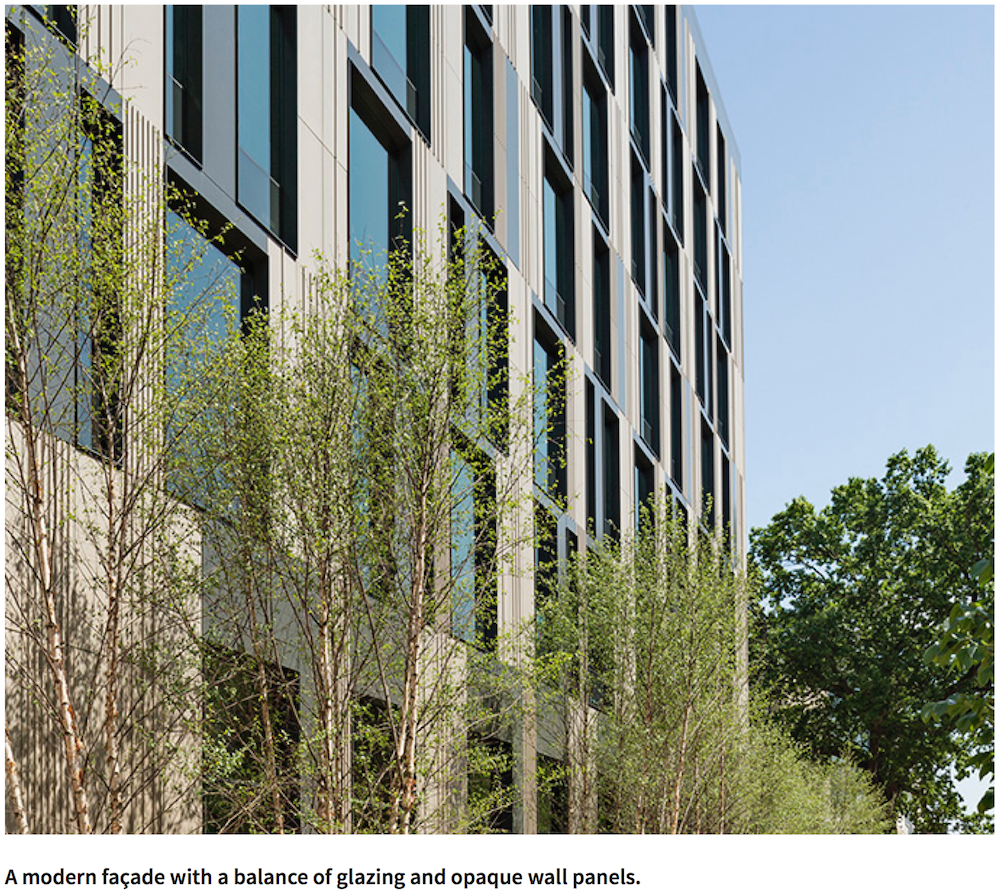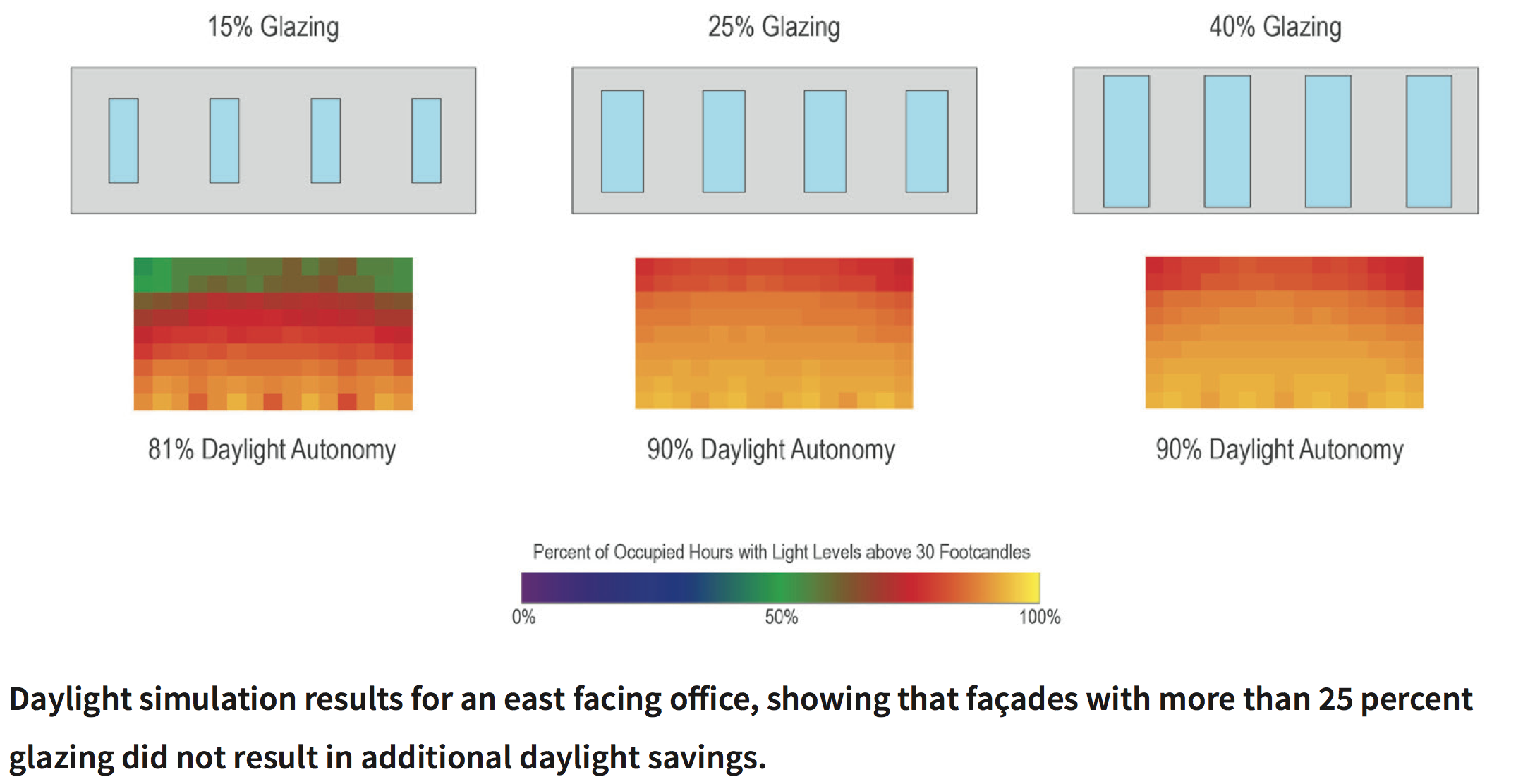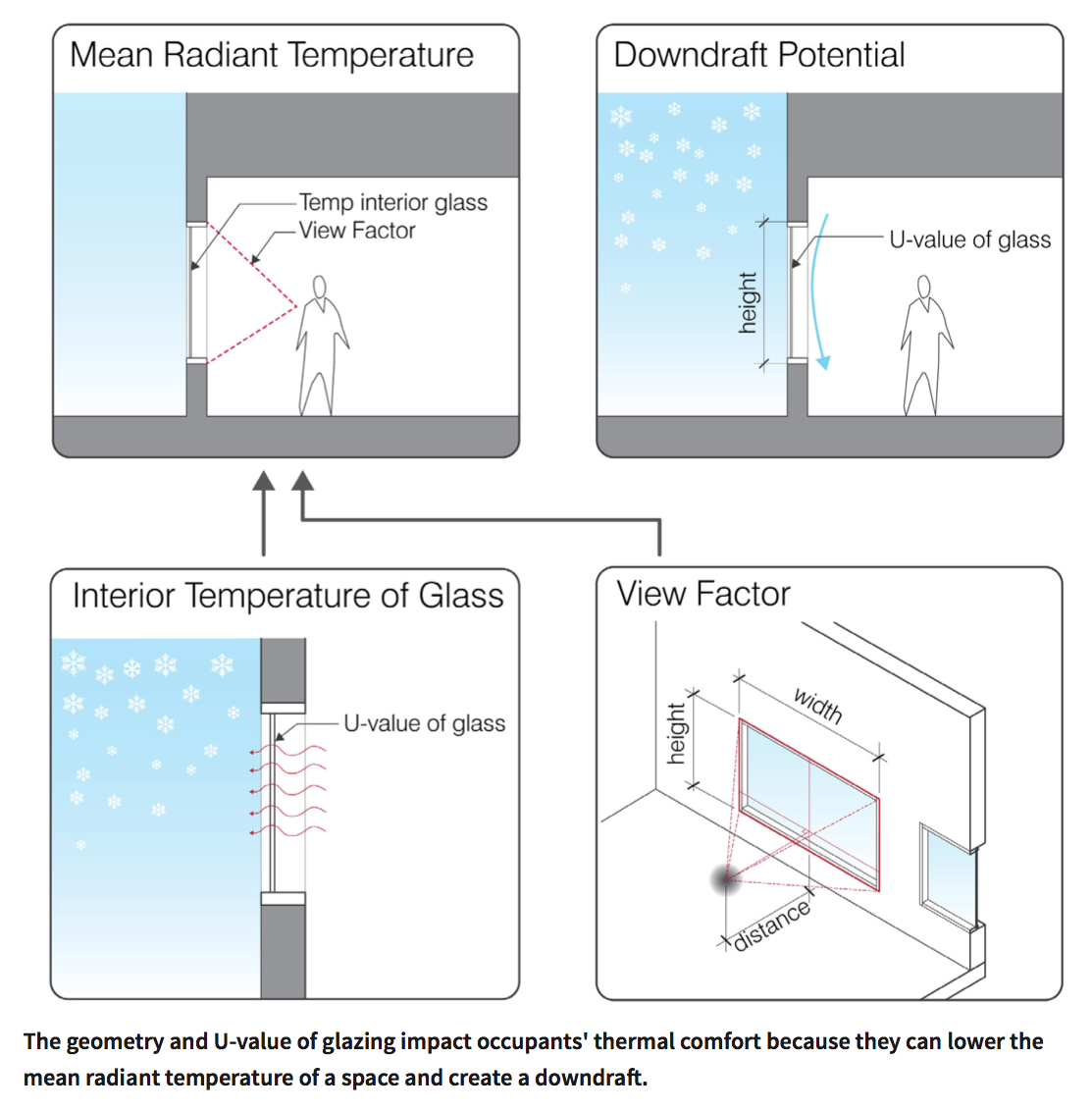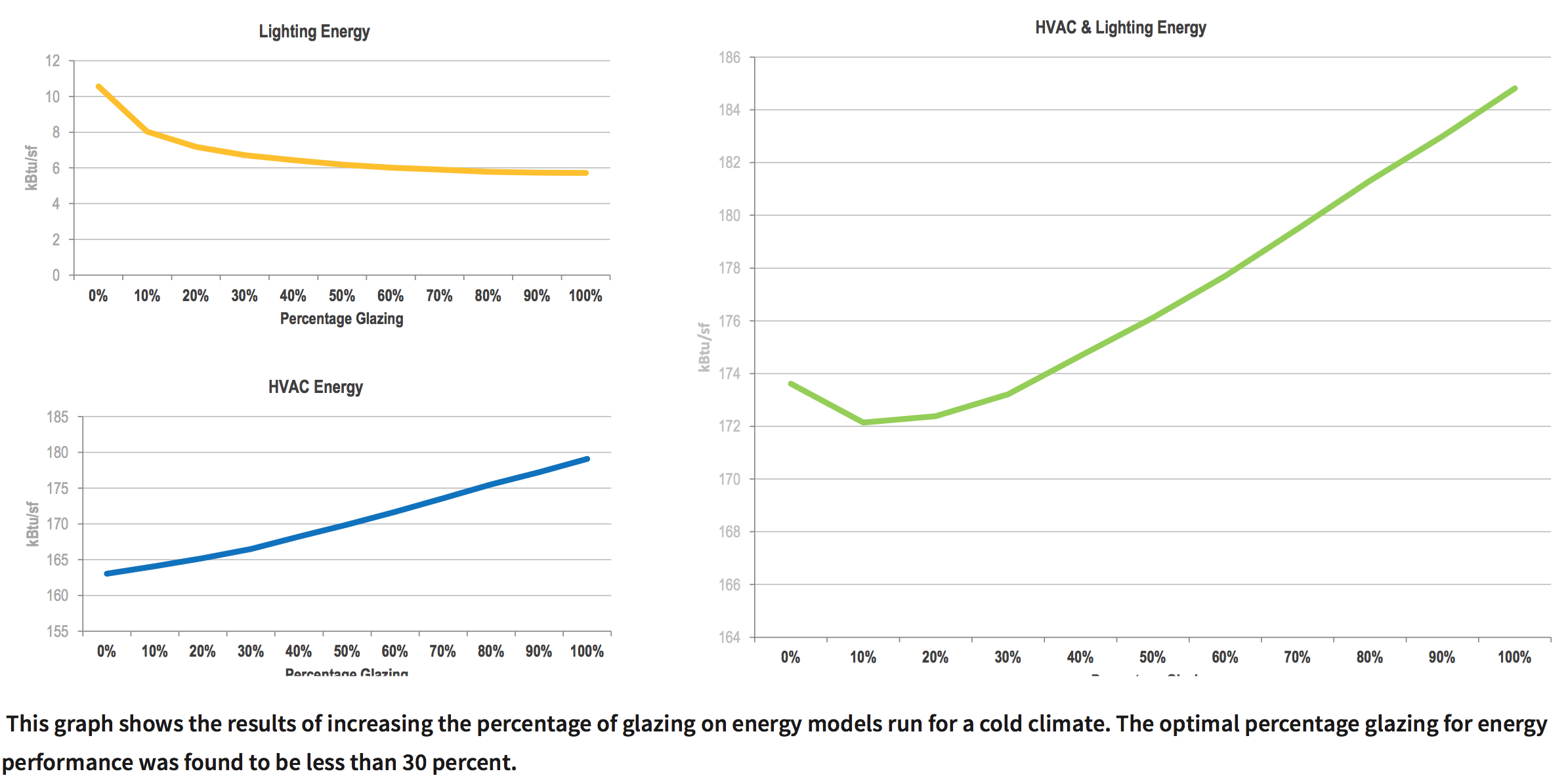
The All-Glass Building
Is Energy Efficiency Possible?
 Glazed towers dominate the skylines of our cities. However, most have been designed with little thought as to the climate in which they are located or the environmental impact they might have. According to the Commercial Building Energy Consumption Survey (CBECS) in 2003, 70 percent of energy use in commercial buildings is from the lighting and HVAC systems. The performance of both of these systems is directly related to the design and performance of the building envelope. Sealed, glazed façades, now so ubiquitous, lead to higher heating and cooling loads as well as glare and thermal comfort challenges.
Glazed towers dominate the skylines of our cities. However, most have been designed with little thought as to the climate in which they are located or the environmental impact they might have. According to the Commercial Building Energy Consumption Survey (CBECS) in 2003, 70 percent of energy use in commercial buildings is from the lighting and HVAC systems. The performance of both of these systems is directly related to the design and performance of the building envelope. Sealed, glazed façades, now so ubiquitous, lead to higher heating and cooling loads as well as glare and thermal comfort challenges.
Despite these challenges, many design teams pursuing sustainability continue to use all-glass façades because of their ability to connect interior and exterior environments. The market continues to demand, and architects to deliver, high glazing percentages for the daylight, views, and marketing potential they provide in green buildings. Such designs are difficult to make energy efficient, but many argue that fully glazed buildings, when designed correctly don't increase a building's energy usage.
The question remains: is an all-glass building a sustainable building?
Daylight
The principal benefit of glass façades is their ability to allow natural light into living and working spaces. Daylight provides high-quality illumination with less radiation than most artificial light sources, including fluorescents. When coupled with a high-performance glazing system, natural daylighting can reduce the heat load that comes from artificial light fixtures. A lighting control system that responds to changes in daylight can yield a dramatic reduction in the building's lighting energy use.
In addition to the energy benefits from daylighting, studies have found numerous psychological benefits. A 1999 study by the Heschong Mahone Group found that students in classrooms with more natural light scored up to 25 percent higher on standardized tests than other students in the same school district. Studies looking at the effect of natural light on productivity date back to the 1920s, when they were conducted on silk weavers; even then, daylight was shown to increase productivity. Numerous subsequent studies have shown improved performance and increased attention and alertness in occupants of daylit buildings.

Exposure to daylight has also been shown increase sales in retail establishments such as Walmart and Whole Foods. Walmart installed a daylighting system in one of its Kansas stores in the 1990s and had store employees rotate goods for sale under the natural light source; items sold better when under daylight.
Daylight has many benefits, but few studies have investigated how much glazing is needed to achieve good quality natural lighting. Most buildings do not need to be completely glazed to benefit from daylighting. For example, the glazed area below a work surface in an all-glass building has minimal impact on the daylight in a space.
Daylight has many benefits, but few studies have investigated how much glazing is needed to achieve good quality natural lighting. Most buildings do not need to be completely glazed to benefit from daylighting.
The rule of thumb in the industry (recommended by organizations such as Lawrence Berkeley National Laboratory) is that only 30 percent glazing is needed for optimum daylighting performance. Our findings at Payette corroborate this figure. Our computer simulations on the impact of the amount of glazing on daylighting have found in multiple projects that the Useful Daylight Illuminance (UDI) does not increase at all beyond 50 percent glazing. UDI looks at how much light a space receives above a specified target but below the threshold of lighting levels that will cause glare and discomfort. For example, a recent investigation for an east-facing office concluded that 40 percent glazing provided no any more useful daylight than 25 percent.
Energy
A well-designed daylighting strategy can decrease a building's light energy use and associated cooling load. However, as lighting power densities decrease with more efficient lighting technologies like LEDs, lighting represents an ever smaller portion of a building's total energy use. Glazing's biggest impact on building energy consumption comes from its impact on a space's heating and cooling loads. The solar heat gain from the sun increases proportionally with the amount of glass on a façade, which in turn increases the energy needed to cool the building.
A number of strategies exist to mitigate solar radiation, from external sun shading to frits and coatings on the glass. A well-designed shading system can significantly decrease but not block all heat gain, particularly on east- and west- facing façades, where low sun angles are particularly challenging.
In a cold climate like New England, the increase in heat loss in the winter as a result of high glazing percentages can significantly impact energy use. The current code requirement for maximum U-values for glazing is seven times higher than that of an opaque wall. Even with code-compliant glazing to high-performance triple glazing, the U-value is still three to four times greater than the maximum allowable for an opaque wall assembly. As a result, fully glazed buildings always have a much higher heating load than more moderately glazed buildings.
Double-skin façades have grown in popularity in recent years as a way to improve the energy performance of all-glass buildings. They work by capturing heat between the two glass walls to reduce winter heat loss and ventilating the same cavity in the summer to minimize heat gain. An integrated sun shading system between the two glass walls can further improve performance in the summer. While the double-skin façade can typically decrease a building's energy consumption in relation to a conventional, fully glazed façade, it still does not perform as well as an opaque wall with glazed openings.
Because lighting energy loads are decreasing and HVAC energy loads are increasing as the amount of glazing increases, an energy model is often the best method to determine the optimal amount of glazing.
While there is some variability based on the building type and climate, we have consistently observed buildings with a moderate amount (around 20 to 30 percent) of glazing use less energy than a fully glazed façade or one having little to no glass.
Comfort
Creating comfortable environments for building occupants in all-glass buildings can be a challenge. Direct solar radiation, particularly in the summer, can create localized hot spots in the building. If the thermostat is not in the sun and is therefore not experiencing the raised temperatures, it will not adjust the HVAC system to make the space comfortable for those in the sun. If the control is in the sun, the HVAC system can overcool occupants that are not directly in the sun, especially in open office spaces. A well-designed solar control strategy, using interior blinds or exterior sun shades, can mitigate this discomfort.
Winter conditions can also pose thermal comfort challenges in all-glass buildings. Because glass does not insulate well, it has a lower interior surface temperature than an opaque wall assembly. This increases the radiant heat transfer that happens between an occupant and the façade, and can make occupants feel cold even at a comfortable air temperature. The colder surface can also create a downdraft along tall vertical pieces of glass. Downdrafts occur as warm interior air hits the cold surface of the glass and falls, creating cold convective currents with temperatures and air speeds that can cause discomfort.
To combat this discomfort in fully glazed buildings, perimeter radiant heating is often added. Using a high-performance assembly, such as triple glazing, will raise the interior surface temperature, decreasing the radiant heat transfer and reducing the downdraft which can often create a thermally comfortable environment without the need for perimeter radiant heating. However, because comfort is determined by both glazing area and the U-value of the assembly, there is a limit to how low the U-value can be without needing mechanical means to create a comfortable environment. For the Boston climate, we have found that full-height glazing (60 to 70 percent glazed or higher) to be the comfort limit with a good triple-glazed window.

Visual discomfort can also be a challenge to control in fully glazed buildings. While increased glazing increases the amount of daylight in a space, you can have too much of a good thing, resulting in overlit spaces at the perimeter that create glare problems. A well-designed exterior shading system or fritted glass can help mitigate glare, but low sun angles in the morning and evening can still pose a challenge. Interior blinds are the most common glare-control strategy. Unless they are automated, however, they frequently are lowered during a brief period of glare and are not raised again. While this controls glare, it erases all of the benefits of daylighting and exterior views that you can get from glass.
Views
Visual connection to the exterior environment and nature is one of the biggest benefits of all-glass buildings. Views to the external environment have been shown to benefit the health and productivity of occupants because of the biophilic connection between humans and other living systems. The most famous of these is the seminal study by Roger Ulrich in 1981 that found that medical center rooms with views improved patient recovery rates by eight percent. As with the daylight studies, the percentage of glazing needed to achieve quality views is unclear. Some argue that punched windows common in buildings with limited glazing act much like a picture frame, allowing access to views while maintaining the thermal integrity of the building envelope.
Aesthetics
Because large panes of glass weren't commonly available until the mid-twentieth century, fully glazed buildings are associated with modernism. Both designers and building owners demand highly glazed buildings to give the image of transparency and modernity. But in an age where we must think about the environmental impact of the built environment, many argue that it is time to end our collective passion for all-glass buildings. Fully glazed buildings have become so ubiquitous that we as designers should embrace the challenge of creating a new image for what it means to be modern in this age. Design is about embracing constraints to create a new and beautiful building, and working with materials other than glass should be embraced as part of our design challenge.
Learn more from Andrea Love about all-glass efficiency in commercial buildings
by attending her sessions and workshop on this topic & LEED 4.0 at BuildingEnergy 15.
Our Mission
NESEA advances sustainability practices in the built environment by cultivating a cross-disciplinary community where practitioners are encouraged to share, collaborate and learn.







Add comment